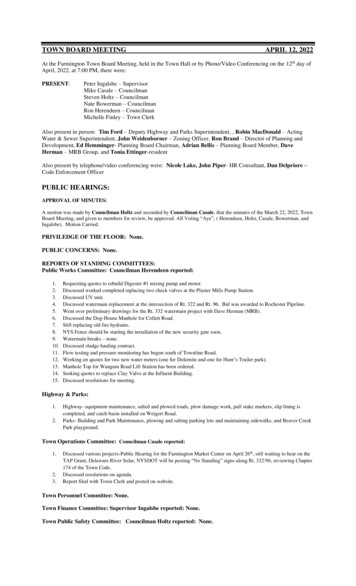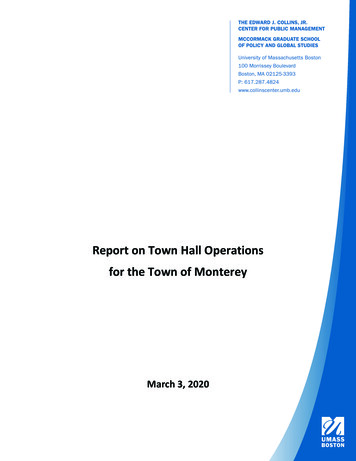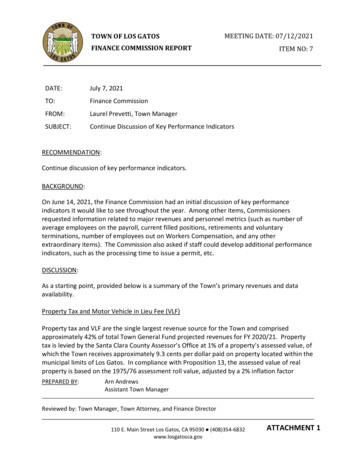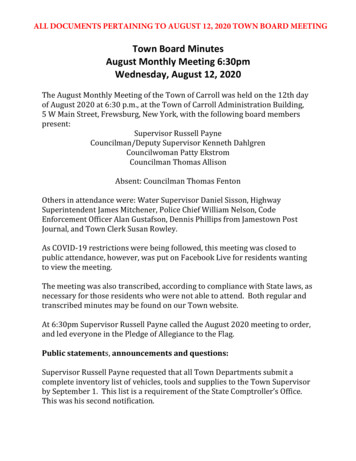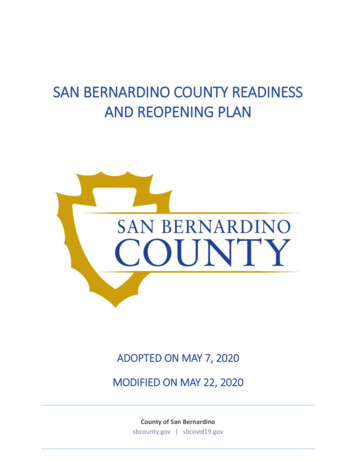
Transcription
[Town of Hempstead/City of Long Beach]Local PlanJuly 1, 2021 – June 30, 20251
Table of ContentsTable of Contents . 1Strategic Planning Elements . 2Local Workforce Development System . 7Workforce Development and Career Pathways. 12Access to Employment and Services. 14Business Engagement. 20Program Coordination . 24Title II Program Coordination . 26Youth Activities . 29Administration. 32Training Services. 35Public Comment . 40List of Attachments . 401Local Plan Template2
Strategic Planning ElementsLocal Workforce Development Areas (LWDAs) and Regional Demand Lists are now maintained online.Changes to the Demand Lists can be made by following the directions on the webpage.I attest that the priority ranked list of the LWDA’s demand occupations was last updated on [specifydate in the text box below].May 21, 2021How is this information shared with the Local Workforce Development Board (LWDB)? What was thelast date on which it was shared?This information will be shared with the Board electronically.a. Provide an analysis of regional economic conditions, including:i.Existing and emerging in-demand sectors and occupations; andThe New York State Department of Labor’s (NYSDOL) Bureau of Labor MarketInformation in the Division of Research and Statistics (R&S) published a report in 2019that outlines the Significant Industries on Long Island. Significant industries in the LongIsland region are Construction; Manufacturing; Trade, Transportation and Utilities;Professional and Business Services; Health Care and Social Assistance; and Leisure andHospitality. These industries are significant because they experience above-average jobgrowth, they employ a significant number of jobs ( 12,500), project job growth for 20162026 is above-average, and/or they pay above-average wages. Although not specificallyidentified as a “significant industry” in the R&S report, Information Technologycontinues to offer occupational growth across the industries mentioned.ii. The employment needs of businesses in those sectors and occupations.The employment needs of businesses in the sectors above continue to expand. R&Sstates that on average, the projected percent change in jobs between 2016-2026 is12.3% sectors, and businesses will need to fill these positions as growth in the industriesoccur. Below are examples of the most in-demand occupations for each industry:Construction: electricians; office clerks; and plumbers, pipefitters, and steamfittersManufacturing: light truck or delivery services drivers; packers and packagers, hand; andinspectors, testers, sorters, samplers, and weighersTrade, Transportation and Utilities: electricians; heating, air conditioning, andrefrigeration mechanics and installers; and carpentersProfessional and Business Services: lawyers; paralegals and legal assistants;bookkeeping, accounting, and auditing clerks; and office clerksHealth Care and Social Assistance: home health aides, medical assistants, nursingassistants, personal care aides and dental assistants2Local Plan Template3
Leisure and Hospitality: drivers/sales workers; combined food preparation and servingworkers, including fast food; waiters and waitresses; and restaurant cooksb. Describe the knowledge, skills, and abilities needed to meet the employment needs of businesses,including those in in-demand sectors and employing individuals in demand occupations.R&S indicates that the following knowledge, skills, and abilities are necessary to meetemployment in the aforementioned sectors:ConstructionThe majority of occupations within this sector is skilled trade. Essential skills aremaintenance, repairs, new work, and alternations.ManufacturingManufacturing remains an important sector in the Long Island economy despiteundergoing significant restrictions over the last decade. The aerospace and defensemanufacturing industry provided a strong base for engineering and research andproduct development. Workers with these skills are an asset in a world wheretechnology and innovation are critical for economic growth.Trade, Transportation and UtilitiesOccupations within this sector are also skilled trade, but communication and sellingskills are necessary.Professional and Business ServicesThis sector includes a variety of industries reflecting Long Island’s wide-ranging skillsand capabilities in science, engineering and technology. Expertise and skills in legal,accounting, architectural, advertising, scientific R&D, and other professional services areessential. Specializations in general management, personnel administration, clericalactivities, and cleaning activities are also critical for employers.Health Care and Social AssistanceDue to the aging Long Island population, there is a greater demand for nursing care forhome patients and patients at assisted living facilities. The opioid epidemic has alsoincreased demand for residential substance abuse facilities.Leisure and HospitalitySkills in this sector include abilities to prepare meals, snacks and beverages to customersfor on-premises or off-premises consumption.NYSDOL’s Employment in New York State March 2021 Newsletter states that “one of thebiggest (positive) surprises of 2020 was how quickly employers (and workers) embraced‘work from home’ (WFH) arrangements during the [COVID-19] pandemic.” This shiftindicates that as telecommuting varies widely by occupation and industry, employersalso need to hire individuals that have the computer skills needed to work remotely.c. Provide an analysis of the regional workforce, including:3Local Plan Template4
i.Current labor force employment and unemployment numbers;As of February 2021, the Long Island region’s unemployment rate was 6.7%, a 2.8percentage increase from February 2020. R&S states that the labor force in the Town ofHempstead and in the City of Long Beach is 389,200 and 19,000, respectively. NassauCounty’s unemployment rate increased from 3.0% to 6.6%, and “by comparison, NewYork State’s rate was 9.6 percent, and the National rate was 6.6 percent.”ii. Information on any trends in the labor market; andThe COVID-19 pandemic’s impact on the labor market is unprecedented. NYSDOL’sEmployment March 2021 newsletter states that in April 2020, the “U.S. lost more than21 million private sector jobs as businesses shut down in the wake of the pandemic,”and that “job losses during the pandemic were largest in service-providing industries,like leisure and hospitality, retail trade and health care.”In addition, R&S reports that “for the year ending January 2021, the number of privatesector jobs on Long Island declined by 113,100, or 10.1%, to 1,007,700. The greatestlosses were in leisure and hospitality (-32,400), trade, transportation and utilities (21,400), educational and health services (-20,900), professional and business services (11,600), other services (-10,900), natural resources, mining and construction (-6,700)and manufacturing (-4,800).”iii. Educational and skill levels of the workforce in the region, including individuals with barriers toemployment.According to the New York State Census Bureau, the educational attainment levels inNassau and Suffolk Counties in 2019 are as follows:Nassau Residents ages 18 to 24High School Graduates: 24.8%Bachelor’s Degree or Higher: 24.7% Residents ages 25 and overHigh School Graduates: 91.9%Bachelor’s Degree or Higher: 47.2%Suffolk Residents ages 18 to 24High School Graduates: 28.0%Bachelor’s Degree or Higher: 19.0% Residents ages 25 and overHigh School Graduates: 26.2%Bachelor’s Degree or Higher: 38.3%d. Provide an analysis of workforce development activities, including education and training, in theregion.i.4Identify strengths and weaknesses of these workforce development activities.Local Plan Template5
The Long Island Workforce Development Boards (LWDBs) lead a sophisticated networkof programs and partnerships, and collaborate with other leaders, such as the LIREDC, tomaintain and constantly improve and expand a comprehensive regional workforcedevelopment system. The Town of Hempstead/City of Long Beach LWDB has expandedthe footprint of the WIOA-mandated workforce development system to the larger, nonmandated system, through its participation on the LIREDC Workforce and EducationWorkgroup, the Long Island Sector Partnership, the Stony Brook UniversityManufacturing Extension Partnership (MEP) Center. Manufacturing and TechnologyResource Consortium (MTRC) and other groups and initiatives. The strengths of theLong Island workforce development activities are that they are broadly collaborativeand benefit from a variety of partnerships. The weakness is that disseminated state andfederal funding and resources sometimes do not foster sufficient coordination with theregional LWDBs.ii. Does the local area have the capacity to address the education and skill needs of the localworkforce, including individuals with barriers to employment, and the employment needs ofbusinesses? Please explain.The local area does have the capacity to address the education and skill needs of thelocal workforce, including individuals with barriers to employment, and businesses. Thiscapacity is illustrated by the Local Area’s long-standing track record of servingthousands of Long Islanders, while consistently surpassing performance goals. TheHempsteadWorks Career Center offers comprehensive services to jobseekers, includingassessment, career counseling, skills training, job placement, follow-up services, andmore. Businesses benefit from job matching, pre-screening, assistance in obtainingtraining funds and tax incentives, on-site recruitment, job fairs, etc. Individuals withbarriers to employment are served by our Career Center staff, partner organizations andyouth contractors. Individuals with disabilities are guided through enhanced services bythe HempsteadWorks Disability Resource Coordinator. WIOA and partner funds areleveraged to target those who are in priority groups and who are most in need ofservices. The Local Board has also obtained several non-WIOA grants to servejobseekers and businesses, such as the United Way of Long Island, funding through theNew York State Office of Temporary and Disability Assistance through TemporaryAssistance for Needy Families, the Empire State Poverty Reduction Initiative, and theNew York Community Bank Youth Services Grant.e. Describe the LWDB’s strategic vision and goals for preparing an educated and skilled workforce,including youth and individuals with barriers to employment.The foundation of the Local Board’s strategic vision and goals for preparing an educatedand skilled workforce, including youth and individuals with barriers to employment, isits overarching vision, which states: “Our vision for the future is one of unprecedentedeconomic prosperity, growth and opportunity for businesses and citizens, along with therealization of the highest quality of life attainable.” To realize this vision, the LocalBoard has established the following mission statement: “Our mission is to ensure thatskilled workers are available to employers; help jobseekers to find work; and fostereconomic development.” The Local Board’s Youth Standing Committee has establishedthe mission “to enhance opportunities for youth in the community to attain the skills,5Local Plan Template6
education and credentials needed to enter the workforce, retain employment andincrease earnings.” The Local Board’s strategy to operationalize these concepts asfollows: i.Equip workers with the knowledge, credentials, skills and abilities to enter andprogress along career ladders within growing and transformative industries thathire for demand occupations;Apply sector-based strategies to identify specific workforce preparationrequirements;Foster robust partnerships designed to plan collaboratively; share resources;leverage augmenting funds and accept mutual accountability;Inform planning and continuous improvement activities with fact-baseddecision-making, using relevant, reliable and data;Utilize co-enrollment, as well as blending and braiding of funds where feasible;Apply customized employment and person-centered planning, as appropriate,particularly for individuals with disabilities;Maintain a systemic culture of quality management that celebrates successesand addresses weaknesses with positive solutions.How do the local area’s workforce development programs, including programs provided bypartner agencies, support this strategic vision?The local area’s workforce development programs, including programs provided bypartner agencies, support this strategic vision through the active participation of ourpartner organizations on our Local Board, its subcommittees, workgroups and grantprojects. Our vision is also supported by our contractors, such as the Long Beach AdultLearning Center, EAC Network and Nassau BOCES. During the most recent planningperiod, the local area led an effort undertaken by the three Long Island Local Boards toform the Long Island Sector Partnership, an initiative funded by a NYSDOL SectorPartnership National Emergency Grant - Regional Sector Partnership DevelopmentGrant. Facilitated by a consultant, Humanity 2.0, and following a model established by aLocal Board member and business partner, Northwell Health, this extended partnershiphas created an unprecedented opportunity for the local area and the region to gathersector-based workforce intelligence and to align that data with collaborative career andtraining services provided by the One-Stop System and its partners. The fosters aprotocol of data collection, consensus building, leveraging of resources, alignment ofprograms and services and collaboration that supports our strategic vision.ii. How will the local area, working with the entities that carry out the core programs, alignavailable resources to achieve the strategic vision and goals?The organizations that provide the core programs are listed below: Adult Career and Continuing Educational Services – Vocational Rehabilitation(ACCES -VR) – Rehabilitation Act; Long Island – Regional Adult Education Network (LIRAEN) Adult Education andFamily Literacy Act; New York State Department of Labor (NYSDOL) Division of Workforce Solutions(DEWS)– Wagner-Peyser program under Title III of WIOA; Trade Adjustment6Local Plan Template7
Assistance (TAA) under Title II of Trade Act; Jobs for Veterans State Grants underTitle 38, U.S.C.; State Unemployment Insurance (UI) programsTown of Hempstead Department of Occupational Resources (DOOR) –Workforce Innovation and Opportunity Act (WIOA) Title I Adult, Youth andDislocated Worker Programs.The local area, working with the entities that carry out the core programs, alignsavailable resources to achieve the strategic vision and goals as described below. Theabove partner organizations integrate services of the core programs into their customerorientations. ACCES-VR, NYSDOL and DOOR are co-located within the HempsteadWorksCareer Center. LI-RAEN constitutes an extensive network of local educational agenciesand other service providers that are accessed by One-Stop Career Center customersthrough staff referrals. Participating network providers also refer their customers to theCenter. Partner staff will work cooperatively to access core programs, plan thesequence of services, remove service gaps, align programs, provide follow-up and shareoutcomes.f.Describe the LWDB’s goals relating to performance accountabilities measures. How do thesemeasures support regional economic growth and self-sufficiency?The Local Board plans to exceed goals negotiated with NYSDOL relating to performanceaccountability measures. These measures support regional economic growth and selfsufficiency because they relate to increased employment, employment retention andearnings, all of which increase the tax base that contributes to government programsand services. These outcomes also correspond to the contribution of more dollars spentwith commercial enterprises, which include everything from real estate to retail andbeyond. Additional outcomes related to skills development and credential attainmentensure that we are developing the highly skilled and educated workforce that localindustries rely on to grow and create jobs.Local Workforce Development Systema. Identify the programs, whether provided by the Career Center or any partners, that are a part of thelocal area’s workforce development system, including:i.Core programs;WIOA requires service delivery under the following core programs: Adult, DislocatedWorker and Youth; Adult Education and Family Literacy Act (AEFLA); Wagner Peyser Actemployment services; and vocational rehabilitation. These core programs are a part ofthe local area’s workforce development system. They are provided as described below:1. Adult, Dislocated Worker and Youth - DOORAdults and dislocated workers have access to the full array of WIOA and partnerservices through the HempsteadWorks Career Center System. It is a network oforganizations that assists employers in hiring qualified workers, and it helps jobseekers to develop their skills and secure employment. The One-Stop CareerCenter provides initial assessment to new customers. This assessmentprocedure requires staff to identify customers who need skills development7Local Plan Template8
and/or training services to obtain their employment goal during the customer’sfirst one-to-one meeting with a staff person. Through the assessment, careercounselors identify barriers to employment and help the customer establish anemployment/occupational goal that is relevant to the local labor market. Theresults of the assessment are entered in the New York State One-Stop OperationSystem (OSOS) and utilized to construct an Individual Employment Plan (IEP).For Out-of-School Youth (OSY), a comprehensive assessment is conducted by theDOOR OSY contractors EAC Network and Nassau BOCES immediately uponcertification of the eligibility for WIOA services. In-School Youth (ISY) areassessed by our network of local education agencies (LEA) coordinators. Thesecoordinators also provide year-round career counseling and case managementservices designed to ensure that participants attain their high school diplomas.The contractors provide both OSY and ISY with preparation for postsecondaryeducational opportunities, linkages between academic and occupationallearning, preparation for employment, effective connections to intermediaryorganizations that provide strong links to the job market and employers. Othercontracted youth services include leadership development, financial literacyworkshops, and entrepreneurial skills training.Due to the COVID-19 pandemic, virtual services have been implemented tomaintain assistance to jobseekers while protecting the health of staff, customersand partners. Services include: Job seekers can register for services available at the career center bycompleting the online career center registration form atwww.hempsteadworks.comFor general information about services, to ask questions, or to requestassistance, including career counseling and job placement, customerscan complete a Job Search/Training Assistance form on theHempsteadWorks websiteCareer development and computer skills training workshops areconducted online. Some of the workshops include interviewing skills,online job applications, Word and ExcelOnline classroom-based occupational skills training is available foreligible customers, as training providers also provide virtual learningalternativesRemote youth services are available for individuals who are notcurrently enrolled in secondary or post-secondary school, and for youthwith disabilities.2. AEFLA - LIRAENThrough referrals to external service provides from HempsteadWorks CareerCenter staff in coordination with the Long Island – Regional Adult EducationNetwork (LI – RAEN), the Local Workforce Development Board (LWDB) providesaccess to employment, training, education and training, and supportive servicesavailable to Title II participants with barriers to employment. DOOR alsocontracts with the Long Beach Adult Learning Center (LBALC) to provide WIOATitle II services to residents of the City of Long Beach, which is somewhat8Local Plan Template9
geographically removed from other AEFLA providers located within the Town ofHempstead.3. Wagner-Peyser program under Title III of WIOA; Trade Adjustment Assistance(TAA) under Title II of Trade Act; Jobs for Veterans State Grants under Title 38,U.S.C.; State Unemployment Insurance (UI) programsThe NYSDOL Division of Employment and Workforce Solutions (DEWS) providesthe Wagner-Peyser program under Title III of WIOA and the Trade AdjustmentAssistance (TAA) under Title II of Trade Act through labor servicesrepresentatives deployed at the HempsteadWorks Career Center. NYSDOLDEWS coordinates the Jobs for Veterans State Grants under Title 38, U.S.C.;State Unemployment Insurance (UI) programs through its Disabled VeteransEmployment representative (DVER) and Disabled Veterans Outreach Program(DVOP) representative. Veterans services are augmented by the LSRs and otherCareer Center staff.4. Vocational RehabilitationACCES-VR provides comprehensive services to individuals with disabilities,including testing, assessment, career counseling, training, job placement, etc.As a key partner in the Disability Employment Initiative (DEI) grant project,ACCES-VR works closely with the HempsteadWorks Disability ResourceCoordinator (DRC) to help individuals with disabilities access services andbenefits, including the Ticket-to-Work Program, to obtain reasonableaccommodations, to utilize adaptive equipment and assistive technology, toaccess interpreter services, etc.ii. Programs that support alignment under the Carl D. Perkins Career and Technical Education Actof 2006; andNassau Community College (NCC) administers the Carl D. Perkins Career and TechnicalEducation Act program in our local area. The college provides funding to the LocalBoard that supports the provision of career development workshops within theHempsteadWorks Career Center. The topics of the workshops include: ResumeDevelopment; Interview/Salary Negotiation; Beginning Social Media; and MasteringLinkedIn. NCC also administers the Workforce Development Training Scholarship andCommunity Health Worker Programs with funding under the Coronavirus, Aid, Relief,and Economic Security Act (CARES Act). The programs prepare low-income andunemployed/underemployed Nassau County residents with training for employment inhigh-demand industries that include health care, business and trades (e.g., HVAC andplumbing) and for work as a Community Health Worker. DOOR is an NCC partner andrefers customers to the school for training.iii. Other workforce development programs, if applicable.Other workforce development programs and how they operate within the localworkforce development system are indicated below: 9Job Corps, operated by Management and Training Corporation – Co-located;10Local Plan Template
YouthBuild, operated by United Way of Long Island – co-located;Older Americans Act Title V Senior Community Service Employment Program Co-located;Title IV of WIOA, operated by New York State Commission for the Blind (NYSCB)Office of Children and Family Services (OCFS) – Cross-referrals;Community Services Block Grants (CSBG) Employment and Training, operated bythe Nassau County Economic Opportunity Commission, Inc. – Cross-referrals;Temporary Assistance for Needy Families (TANF) Employment and Trainingunder Part A of Title IV of Social Security Act, operated by Nassau CountyDepartment of Social Services – Cross-referrals;Disability Employment Initiative, operated by DOOR under a grant fromNYSDOL;Trade and Economic Transition National Dislocated Worker Grant, operated byDOOR under a grant from NYSDOL;Opioid National Dislocated Worker Grant, operated by DOOR under a grant fromNYSDOL;Employment Recovery National Dislocated Workers, operated by DOOR under agrant from NYSDOL;Consolidated Funding Application (CFA) 9.0 Unemployed Worker Training Grant,operated by DOOR under two grants from NYSDOLb. Describe how the local area will ensure continuous improvement of services and service providers.The local area will ensure continuous improvement of services and service providersthrough the oversight of the Local Board. This oversight conforms to the monitoringrequirements of the HempsteadWorks Policy and Procedure Manual, theHempsteadWorks Oversight Plan, the contractual agreement with the HempsteadWorksOne-Stop Operator, contractual agreements with subrecipients and vendors, andmemoranda of understanding with partners, etc. By contract, the One-Stop Operator isrequired to submit the One-Stop Operator Annual Report, which is responded to by theLocal Board with feedback and instructions for corrective action or improvement. TheAnnual Report is reviewed for deficiencies and corrective action is ordered andimplemented as appropriate. The board also reviews quarterly Primary Indicators ofPerformance Reports and Monthly Customer Service Indicators Reports that are issuedby the New York State Department of Labor. The data in this report serves as afoundation for continuous improvement decisions. The information on employment,wage, training and training related placement data is reviewed to determine thatproviders are meeting employment needs of local businesses. In addition, theHempsteadWorks Quality Assurance Program (HWQAP), an award-winning automatedtool, is utilized as the basis of fact-based, quality management and continuousimprovement. The program measures customer satisfaction by analyzing a series ofsurveys.c. Describe how eligible providers will meet the employment needs of local businesses, workers, andjobseekers.Eligible providers will meet the employment needs of local businesses, workers, andjobseekers by continuing to participate in a procurement process through which the1011Local Plan Template
Local Board selects providers in a manner consistent with its industry sector-basedcareer pathways development strategies, by preparing students for occupations that arein demand in growth industries, by requiring requires demonstrated effectiveness inachievement of outcomes, by supporting the local area’s attainment of primaryindicators of performance, and by responding to customer demand. This procurementgoes above and beyond the requirements of the New York State Eligible TrainingProvider List (ETPL). The selection of eligible providers, as well as their continuingeligibility, is informed by feedback from businesses, participants and jobseekers, alongwith performance outcomes and monitoring findings.d. Describe the roles and resource contributions of the Career Center partners.e. The roles and resource contributions of the Career Center partners is describedin the matrix below.PartnerRoleResource ContributionManagement and Training Administer WIOA Title IOutreach and TrainingCorporationJob Corps ProgramEconomic OpportunityAdminister CommunityEmployment and TrainingCommission of NassauServices Block GrantServicesCounty, Inc.ProgramNassau Community College Administer the Career and Education and TrainingTechnical EducationPrograms at the PostSecondary Level under thePerkins Career andTechnical Education ActNassau CountyAdminister the Temporary ReferralDepartment of SocialAssistance to NeedyServicesFamilies Employment andTraining under Part A ofTitle IV of the SocialSecurity Act ProgramNew York StateAdminister the WIOA Title RehabilitationDepartment of ChildrenIV Rehabilitation Actand Family ServicesProgramCommission for the BlindNew York StateAdminister the WagnerEmployment, Training andDepartment of LaborPeyser program under Title Veterans ServicesIII of WIOA (WP) TradeAdjustment Assistance(TAA) under Title II ofTrade Act Jobs forVeterans State Grants(Vets) under Title 38,U.S.C. StateUnemployment Insurance(UI) programs1112Local Plan Template
New York State EducationDepartment Adult Careerand Continuing EducationServices - VocationalRehabilitationNew York State EducationDepartmentTown of HempsteadDepartment of SocialServicesUnited Way of Long IslandUrban League ofWestchesterAdminister the WIOA TitleIV Rehabilitation ActProgramRehabilitationAdminister the WIOA TitleII Adult and Family LiteracyAct ProgramAdminister the WIOA TitleI Adult, Dislocated Workerand Youth ProgramsAdminister the WIOA TitleI YouthB
Nassau and Suffolk Counties in 2019 are as follows: Nassau Residents ages 18 to 24 High School Graduates: 24.8% achelor's Degree or Higher: 24.7% Residents ages 25 and over High School Graduates: 91.9% achelor's Degree or Higher: 47.2% Suffolk Residents ages 18 to 24 High School Graduates: 28.0% achelor's Degree or Higher: 19.0%
